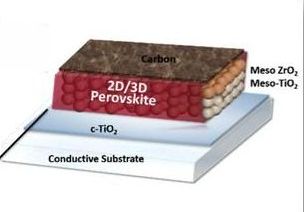By Gary Elinoff, contributing writer
Speaking at a session of the EuroNanoForum conference in Malta, Artur Kupczunas of Saule Technologies described his company’s efforts to produce solar panels an order of magnitude thinner than human hair by exploiting perovskite crystals. The technique is not only far cheaper than conventional silicon-based cells, but also has the advantage of being printable on a wide range of surfaces, including present-day smartphone surfaces.
However, problems remain, with atmospheric oxygen and humidity being the chief culprits. While efficiencies of 31% are potentially achievable and lab-based presentations of 22% have been demonstrated, stability is a major barrier to commercialization. The solar cells built so far using perovskites just can’t stand up to real-world conditions that must be endured outside the protected environment of a research lab.
What are perovskite crystals?
These materials were originally discovered in Russia’s Ural Mountains in the 19th century and named after the Russian minerologist L.A. Perovki. The basic chemical formula is ABC3 , with A and B being two cations and C being the anion that binds them, and they can be fabricated using techniques well familiar to manufacturers of thin-film silicon solar cells.
Steps toward practicality
Recently, as reported in ScienceAlert, a group at the Ecole Polytechnique Fédérale de Lausanne (EFPL) in Switzerland has produced a solar cell that can survive in the real-world environment and produce electricity from sunlight at an efficiency of 11.2%. In collaboration between Mohammad Khaja Nazeeruddin’s group at EPFL, Michael Grätzel, also of EPFL, and the Solaronix Corporation, the effort employed two different types of nanoparticles; 2D and 3D perovskite, with the former providing insulation against oxygen and water, and the latter providing the electricity.

Perovskite solar cell. Source: Ecole Polytechnique Fédérale de Lausanne (edited).
In this laboratory-based example, both types of perovskites were synthesized using the ordinary means of wet chemistry. The complete 2D/3D solar cell was built, sandwich-like, by orienting the two variations of perovskites on top of each other, as illustrated above.
Michael Grätzel, who before this project produced a perovskite solar cell that hit 15% sunlight conversion efficiency in the lab, noted last year in the MIT Technology Review that “The material is dirt cheap.” And, as noted by Solaronix, another of the partners in the enterprise with long-term experience in nano-particle synthesis and the printing of nano-inks, less than a gram of the perovskite material is enough to generate electricity over an entire square-meter solar cell.
Advertisement
Learn more about Electronic Products Magazine





